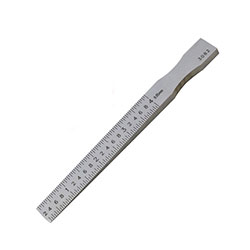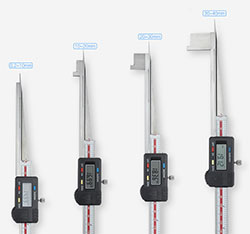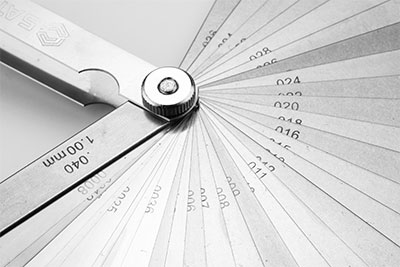What is a Feeler Gauge?
Feeler gauge is a measuring tool used to measure the length, diameter, width, thickness, and other linear dimensions of an object. It usually consists of two movable legs or hooks that can be opened and closed, clamp the object being measured, and then read the measurement results. Feeler gauges are usually used for precise measurements, especially in mechanical manufacturing, engineering, scientific laboratories, and other fields.
Types of Feeler Gauges
There are many types of feeler gauges, and now ATO Store will introduce commonly used ones: single piece feeler gauges and digital display feeler gauges.
Single Piece Feeler Gauge
- Display method: A single piece feeler gauge usually uses a dial or threaded rod to display the measurement results. Users need to read the measurement results by visual inspection or aligning two scale scales.
- Operation: Usually manual, the user needs to manually open and close the measuring head to clamp the measured object, and then read the scale on the dial or threaded rod.
- Accuracy: Single piece feeler gauges typically provide high accuracy, but reading may require more attention and skill.

Digital Display Feeler Gauge
- Display method: The digital display type feeler gauge uses a digital display screen to directly display the measurement results. This type of digital display is usually easier to read and record.
- Operation: Usually electronic operation, users only need to lightly touch the button or clamp the measuring head onto the measured object, and then read the value on the digital display screen.
- Accuracy: Digital display type feeler gauges typically have high accuracy and are easier to read, reducing the possibility of human error.

Overall, the digital display type feeler gauge has the following advantages compared to a single piece feeler gauge:
Easier to read: The digital display provides intuitive measurement results without the need for visual inspection or estimation.
More convenient for recording: Digital display type feeler gauges usually have data output or recording functions, which can transmit measurement results to computers or other devices for further analysis and archiving.
Reducing human error: The electronic operation of digital display type feeler gauges reduces the risk of user error.
Usage Method of Feeler Gauges
- Wipe the measuring surface of the feeler gauge clean with a clean cloth. Do not measure with the feeler gauge stained with oil or metal powder, otherwise it will affect the accuracy of the measurement results.
- Insert the feeler gauge into the measured gap and pull it back and forth. If there is slight resistance, it indicates that the gap value is close to the value marked on the feeler gauge. If the resistance is too large or too small when pulling, it indicates that the gap value is less than or greater than the value marked on the feeler gauge.
- When measuring and adjusting the gap, first select a feeler gauge that meets the gap regulations and insert it into the measured gap. Then, adjust and pull the feeler gauge until there is slight resistance, and tighten the locking nut. At this time, the value marked by the feeler gauge is the measured gap value.
Notes when Using Feeler Gauges
- It is not allowed to bend the feeler gauge violently during the measurement process, or insert the feeler gauge into the gap being tested with significant force, otherwise it will damage the measurement surface of the feeler gauge or the accuracy of the part surface.
- After use, the feeler gauge should be wiped clean and coated with a thin layer of industrial petroleum jelly. Then, the feeler gauge should be folded back into the clamp frame to prevent rust, bending, or deformation and damage.
- When storing, do not place the feeler gauge under heavy objects to avoid damaging the gauge.

Maintenance of Feeler Gauges
- Each shift of surveyors shall inspect once to see if the appearance is clean, whether it is within the calibration period, whether the zero is accurate, whether there is rust, and fill in the instrument inspection form.
- If a certain piece or pieces cannot be used due to rust or severe wear, those pieces can be removed, and this feeler gauge can still be used.
- The feeler gauge is prone to rusting and should be carefully maintained. Spray a small amount of anti-rust oil every day after work and put it into the box (as shown in the figure below). If there is slight rust, it can be gently wiped with sandpaper. After wiping, it must be corrected and confirmed before use.
- Spray a small amount of anti-rust oil after use and then put it into the box.
- Maintenance must be carried out with anti-rust oil 10 minutes before leaving work every day. After each shift, before use, it must be carefully checked again. If there are any abnormalities or equipment problems, please consult the measuring engineer in a timely manner.
- Verify once a year.
In summary, feeler gauges are common measurement tools in many industries and applications, as they provide accurate and reliable measurement results, which are crucial for ensuring manufacturing quality and meeting accuracy requirements.

